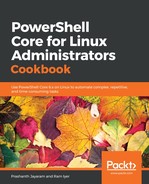Book Description
Use PowerShell 6.0 on Linux to automate complex, repetitive, and time consuming tasks
About This Book
- Understand PowerShell’s object-oriented approach, and truly cross-platform capabilities, which work equally well on Windows, Linux and macOS.
- Extend your OMS capabilities to get rich insights about your Linux workloads to quickly remediate any issues.
- A recipe-based guide that will enhance your native Linux capabilities with PowerShell 6.0.
Who This Book Is For
If you are system administrator who wants to learn to control and automate your Linux environment with PowerShell 6.0 then, this book is for you. Basic knowledge of PowerShell scripting would be necessary. Very basic knowledge required with respect to how an operating system is structured and how to use the command line interface to work with the operating system.
What You Will Learn
- Understand the fundamentals of .NET Core and PowerShell
- Understand the advanced concepts of .NET Core and PowerShell
- Learn to write PowerShell scripts and functions with the best practices in mind
- Take a deep dive into administering computers locally as well as remotely using PowerShell
- Use PowerShell for advanced administration such as on the Cloud, Docker containers, VMware and SQL Server
In Detail
PowerShell is an implementation of .NET Core. .NET Core is a cross-platform open source management framework, which adheres to POSIX standards and makes available API calls that work well with all of the major operating systems: Windows, Linux and macOS. .NET Core for Linux has been a success, because of its adherence to standards, as well as for its lightweight implementation. PowerShell extends the capabilities towards management of Linux servers as well as using containerizers such as Docker.
This book will include real-world examples on how you can use core PowerShell functions to effectively administer Linux-based systems and environments. Later, this book will cover interesting recipes on how system administrators can make use of PowerShell 6.0 to quickly automate complex, repetitive and time-consuming tasks. This book will also teach you to develop scripts to automate tasks that involve systems and enterprise management. By the end of this book, you will also understand your OMS automation capabilities to apply, monitor, and update configurations, gaining real-time visibility into your Linux workloads to quickly get it resolved.
Style and approach
With a recipe-based approach, we will help you take advantage of PowerShell 6.0 to call all native Linux capabilities to automate your environment.
Downloading the example code for this book. You can download the example code files for all Packt books you have purchased from your account at http://www.PacktPub.com. If you purchased this book elsewhere, you can visit http://www.PacktPub.com/support and register to have the code file.
